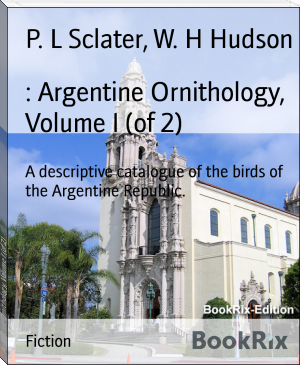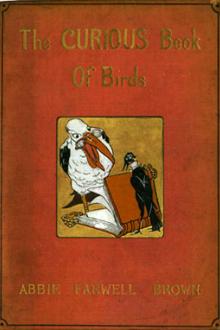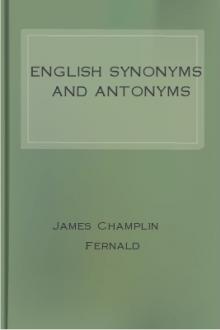: Argentine Ornithology, Volume I (of 2), P. L Sclater, W. H Hudson [best authors to read txt] 📗

- Author: P. L Sclater, W. H Hudson
Book online «: Argentine Ornithology, Volume I (of 2), P. L Sclater, W. H Hudson [best authors to read txt] 📗». Author P. L Sclater, W. H Hudson
+Cnipolegus hudsoni+, _Scl. P. Z. S._ 1872, p. 541, pl. xxxi. (Rio
Negro).
_Description._--Uniform dull black; a broad bar across the bases of
the inner webs of the wing-feathers white; two outer primaries much
pointed at their extremities; bill plumbeous, feet black: whole
length 6·0 inches, wing 2·8, tail 2·6.
This species is at once distinguishable from the preceding (_C.
anthracinus_) by its smaller size and the peculiar narrowed outer
remiges.
_Hab._ Northern Patagonia.
This species is found in the western provinces of the Argentine
Republic, and, like _C. anthracinus_, which it closely resembles, is a
summer visitor in Patagonia, where it makes its appearance in October.
The plumage is intense black, with the inner webs of the remiges at
their base white, but the wing-band, which is over an inch in breadth,
shows only when the bird flies. There is also a small white spot on the
flank, scarcely visible, and excepting for this speck the bird at rest
appears entirely black. When it flies the white band appears suddenly,
producing a curious effect, for the wings are opened and shut
successively and with great rapidity, making the white band appear like
a succession of flashes. All the movements of the bird are eccentric to
a degree. It selects a dead twig on the summit of a bush, and this perch
it occupies during many hours every day. Occasionally it darts after a
passing insect, but I believe it feeds principally on the ground, like
_Lichenops perspicillatus_. At intervals it quits its perch very
suddenly and revolves round it with the rapidity of a moth whirling
round the flame of a candle, the wings producing a loud humming sound,
and the bird uttering a series of sharp clicking notes. During this
performance the white wing-band appears like a pale mist surrounding
the bird. This fantastical dance over, it resumes its perch, and, until
moved to a second display, sits as motionless as a bird carved out of
jet.
128. CNIPOLEGUS CYANIROSTRIS (Vieill.). (BLUE-BILLED TYRANT.)
+Cnipolegus cyanirostris+, _Burm. La-Plata Reise_, ii. p. 457
(Mendoza): _Scl. et Salv. Nomencl._ p. 43; _Barrows, Bull. Nutt.
Orn. Cl._ vol. viii. p. 141 (Entrerios).
_Description._--Uniform dull black; inner webs of the wing-feathers
margined with dull white; bill plumbeous, feet dark brown: whole
length 5·7 inches, wing 3·0, tail 5·6. _Female_ dark cinnamomeous
brown, brighter on the head and rump; wings blackish, wing-coverts
and secondaries edged with pale rufous; tail blackish brown, outer
margins of outer rectrices and inner webs of all the rectrices,
except the two middle, bright rufous; below pale fulvous, densely
striated with blackish; bill and feet brown.
_Hab._ S. Brazil, Paraguay, Uruguay, and La Plata.
In size this species of Black Tyrant is but slightly smaller than the
one described, and the colour is also of an intense black, but the
white wing-band is less conspicuous, the borders only of the inner webs
of the quills being white. It also differs in having a bright blue
beak and red eyes. Azara discovered it in Paraguay, and described the
brown-plumaged female as a distinct species. He merely says that it sits
on the summit of a bush and darts after passing insects, but it will, no
doubt, be found to possess some curious performing habits like the other
species of the genus.
Mr. Barrows met with this species on the Lower Uruguay, in the month of
September, and Burmeister obtained it near Mendoza.
129. CNIPOLEGUS CABANISI, Schulz. (CABANIS'S TYRANT.)
+Cnipolegus cabanisi+, _Schulz, Journ. f. Orn._ 1882, p. 462.
_Description._--Nearly uniform olivaceous slate-colour; below rather
paler; wings and tail black: whole length 6·0 inches, wing 3·4, tail
3·1. _Female_ brownish olive, below paler; wings blackish, slightly
edged with rufous; tail black, with broad rufous margins to the
inner webs, and narrow similar margins to the outer webs; bill and
feet brown.
_Hab._ Tucuman.
This is one of Herr Schulz's discoveries in Tucuman. He met with it, in
the month of January, in the mountainous districts of that province.
130. CNIPOLEGUS CINEREUS, Scl. (CINEREOUS TYRANT.)
+Cnipolegus cinereus+, _Scl. et Salv. Nomencl._ p. 43; _Döring,
Journ. f. Orn._ 1878, p. 197 (Cordova); _Salvin, Ibis_, 1880, p.
357, pl. x. (Tucuman, Salta).
_Description._--Dark cinereous, paler and more olivaceous on the
back and wings; edges of wing-coverts and secondaries rather
lighter; below paler, throat and breast blackish, like the head;
inner margins of wing-feathers whitish; outer primaries acuminated;
bill plumbeous, feet black: whole length 4·6 inches, wing 2·2,
tail 2·3. _Female_ brownish cinereous; cap and rump rufous; wings
blackish, tips of coverts and edges of outer secondaries whitish;
tail blackish, inner webs of all the lateral rectrices, except the
tips, rufous; beneath whitish.
_Hab._ Northern Argentina.
131. LICHENOPS PERSPICILLATUS (Gm.). (SILVER-BILL TYRANT.)
+Lichenops perspicillatus+, _Burm. La-Plata Reise_, ii. p. 457 (La
Plata to Mendoza); _Scl. et Salv. P. Z. S._ 1868, p. 141 (Buenos
Ayres); _iid. Nomencl._ p. 43; _Hudson, P. Z. S._ 1869, p. 432
(Buenos Ayres); _Gibson, Ibis_, 1880, p. 21 (Buenos Ayres);
_White, P. Z. S._ 1882, p. 604 (Buenos Ayres); _Barrows, Bull.
Nutt. Orn. Cl._ vol. viii. p. 141 (Entrerios, Azul).
_Description._--Uniform black; primaries pure white, with black tips
and bases; fleshy ring around the eye and bill yellow, feet black:
whole length 5·6 inches, wings 3·5, tail 2·4. _Female_ above dark
brown, with light brown edgings to the feathers; remiges chestnut,
with dark-brown tips; wing-coverts dark brown with fulvous
tips; beneath fulvous white, breast with dark striations; under
wing-coverts fulvous; bill yellowish, feet black.
_Hab._ Southern Bolivia, S.E. Brazil, Paraguay, Uruguay, La Plata,
Chili, and Patagonia.
Naturalists have said a great deal about the well-known Silver-bill (the
most important member of my "_Spectacular_" group), the question as to
whether the black and red birds are sexes or two distinct species having
long remained unsettled. Azara, writing in the last century, under the
heading _Pico de Plata_, rightly described the red bird as the female of
the black; but, unfortunately, in another part of his work he described
the female again as a different species, naming it _Suiriri chorreado_.
Darwin also separated the sexes, and gave the name of _Lichenops
erythropterus_ to the red-plumaged bird. The following extract gives
only a portion of his argument, and is interesting to read, even now,
when the question has been finally set at rest, as it shows how much
the two birds differ:--"The tail of _L. erythropterus_ is squarer and
contains only ten feathers instead of twelve: the wing is 4/10 of an
inch shorter; and the secondaries relative to the primaries are also
shorter. The red colour on the primaries represents but does not
correspond with the white on the black feathers of _L. perspicillatus_;
and the secondaries in the two birds are quite differently marked.
In _L. erythropterus_ the third, fourth, and fifth primaries are the
longest, and are equal to each other; the second is only a little
shorter than the third. In _L. perspicillatus_ the third is rather
shorter than the fourth and fifth; and the second is proportionately
shorter relative to the third, so that the outer part of the wing in
this species is more pointed than in _L. erythropterus_. The outer
claw in the latter species is only in a small degree straighter than
in the former; and this, considering that _L. perspicillatus_ is
generally perched, and when on the ground can only hop, and that _L.
erythropterus_ feeds there entirely, and walks, is very remarkable."
When one considers the habits of the two birds, even where they are most
abundant and seen continually, it is indeed difficult to believe that
they are of the same species. They are never seen associating together,
even in the love-season, and when I have watched a pair actually engaged
in constructing their nest, they appeared to keep as far apart as
possible. More than that, the male, while unfriendly towards all other
species, appears to cherish a special antipathy against the red bird;
and when one comes near him never fails to pursue it with the greatest
virulence from the neighbourhood. He is also strictly solitary, but the
red birds frequently unite in small parties, especially in autumn, when
I have often seen as many as a dozen together.
Altogether the Silver-bill has been a puzzle in the past, and it would
now appear, from some recent observations made by Mr. Barrows, that we
have not yet got to the end of all the curious points in its habits.
Without doubt it is migratory. Its range extends from Paraguay to
Patagonia, where it is not common. In Paraguay and the hotter parts of
the Argentine country it is probably stationary; in Buenos Ayres, where
it is most abundant, many individuals remain all the year in sheltered
places, and the migration appears to become more definite the further
south we get. Mr. Barrows travelled south across the pampas in the
autumn, and says:--"The species was met with at all points visited,
but south of the Azul not a single male in the black plumage was seen,
though the brown birds (presumably females or young) were met with
almost every day for nine weeks, and frequently in large numbers. Of
course I began to suspect that the males must moult into a brown suit
after nesting, as do our Bobolinks and many other birds, but I shot
specimens at various times, and all proved to be either females or young
males, and as I was confident that at Concepcion black males were to be
found through the year, I was at a loss for an explanation, and am so
still."
The





Comments (0)